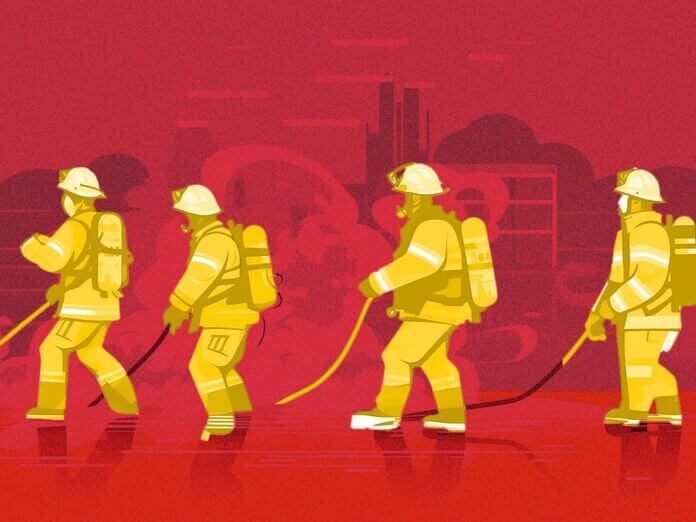
Zac Amos – September 26, 2024
Collected at: https://www.iotforall.com/8-ways-iot-is-saving-firefighters-lives
The Internet of Things (IoT) boosts safety in high-risk environments like firefighting by connecting devices that deliver real-time data and seamless communication. Firefighters with IoT-enabled gear can monitor their vital signs, track their location, and receive live updates on environmental conditions. These factors help them navigate dangerous situations more effectively.
Current data is crucial in these life-or-death moments. It enables commanders to make quick decisions, adjust strategies, and ensure timely evacuations if needed. This constant flow of information enhances situational awareness, streamlines operations, and makes firefighting safer and more efficient.
IoT for Firefighters
#1: Wearable Sensors for Health Monitoring
Wearable devices tracking vital signs — like heart rate and body temperature — are becoming pivotal for responder safety. In 2022, over 65,000 firefighter injuries occurred in the line of duty, highlighting the importance of real-time health monitoring. These smart sensors constantly watch a firefighter’s physical condition and alert command centers if something’s off.
Whether a heart rate spike or dangerously high body temperature occurs, the sensors send out alerts, allowing quick decisions that can prevent serious injury. Offering this level of protection allows the wearable tech to help authorities stay safer during high-risk operations.
#2: Gas and Air Quality Sensors
IoT sensors detecting dangerous levels of carbon monoxide and other harmful gases are crucial in keeping firefighters safe from invisible dangers. These devices continuously monitor air quality and scan harmful substances. When they detect unsafe levels, the sensors instantly alert authorities and command centers to ensure everyone knows the hazard.
This feature allows responders to evacuate or take necessary precautions before the situation escalates. Providing air quality data helps reduce the risk of respiratory issues and long-term health impacts from exposure to hazardous gases.
#3: IoT-Enhanced Firefighting Training Simulators
IoT-based simulators improve firefighter training by creating highly realistic, immersive environments that help fill the skills gap left by retiring professionals. As public safety agencies face staffing shortages, these simulators provide recruits with hands-on experience.
Real-time data from sensors and IoT devices lets them mimic actual fire conditions, from heat levels to air quality to building layouts. This allows trainees to practice under lifelike conditions in a safe, controlled setting.
Firefighters can use this advanced, data-driven training to improve their preparedness and response times. It equips them to handle emergencies with greater confidence and skill.
#4: Connected Firefighting Vehicles
IoT integration in fire trucks and emergency vehicles helps streamline route planning and ensures equipment is always ready for action. Teams can use data to plan the fastest, safest route to the scene, avoiding traffic or dangerous areas. IoT sensors also monitor vehicle performance and equipment status to ensure everything is in working order before arriving.
Firefighters even receive live updates on fire conditions during transit, which gives them critical information to prepare and strategize. This smart technology boosts efficiency and ensures authorities are fully equipped and ready to respond when they arrive.
#5: Drone Surveillance
IoT-powered drones benefit firefighting by offering aerial surveillance during emergencies. Advanced obstacle detection capabilities allow them to easily navigate rugged terrain, making them invaluable in hard-to-reach locations.
As they fly, they provide responders with live data on fire spread, building stability, and potential hazards. This information allows teams to make faster, more informed decisions to help them strategize and respond to the situation more precisely. The use of drones enhances safety and improves overall firefighting efficiency.
#6: GPS-Enabled Location Tracking
Tracking authorities in real-time during emergencies is essential for safety and efficiency. NASA and the Department of Homeland Security have developed a system capable of locating firefighters within a 70-meter range from emergency vehicles outside the building. This feature allows command centers to monitor their teams even in complex, dangerous environments.
IoT solutions can track each firefighter’s moments and adapt their strategies based on live data. This ensures better coordination, faster responses to changing conditions, and more informed decision-making. The ability to see where every responder is in real time reduces risks and improves overall emergency response efforts.
#7: Smart Hydrant Systems
IoT technology allows fire hydrants to connect to central systems and provide real-time water flow and availability data. This ensures firefighters access accurate water supply information before they reach the scene, helping them plan more efficiently.
Constantly monitoring water pressure and flow reduces the risk of equipment failure and ensures responders can rely on a steady source when it’s most needed. This insight allows teams to confidently approach emergencies, knowing one of their most critical resources is always ready and dependable.
#8: Thermal Imaging Cameras for Visibility
IoT-connected thermal cameras are handy for firefighters because they help them see through thick smoke and navigate dangerous environments with greater safety. These cameras detect heat signatures and allow responders to locate individuals, hot spots, and escape routes in low-light or smoke-filled conditions.
In 2022, eight firefighters tragically lost their lives after being trapped in debris, underscoring the critical need for improved visibility during emergencies. Enhancing sight in otherwise blinding conditions reduces the risk of injury. It gives authorities a crucial advantage when time and safety are at stake.
The Future of the IoT in Emergency Services
The future of IoT technologies in emergency services holds immense potential because they offer smarter, real-time solutions that enhance safety, efficiency, and decision-making. As these innovations evolve, they will protect first responders and the communities they serve.

Leave a Reply